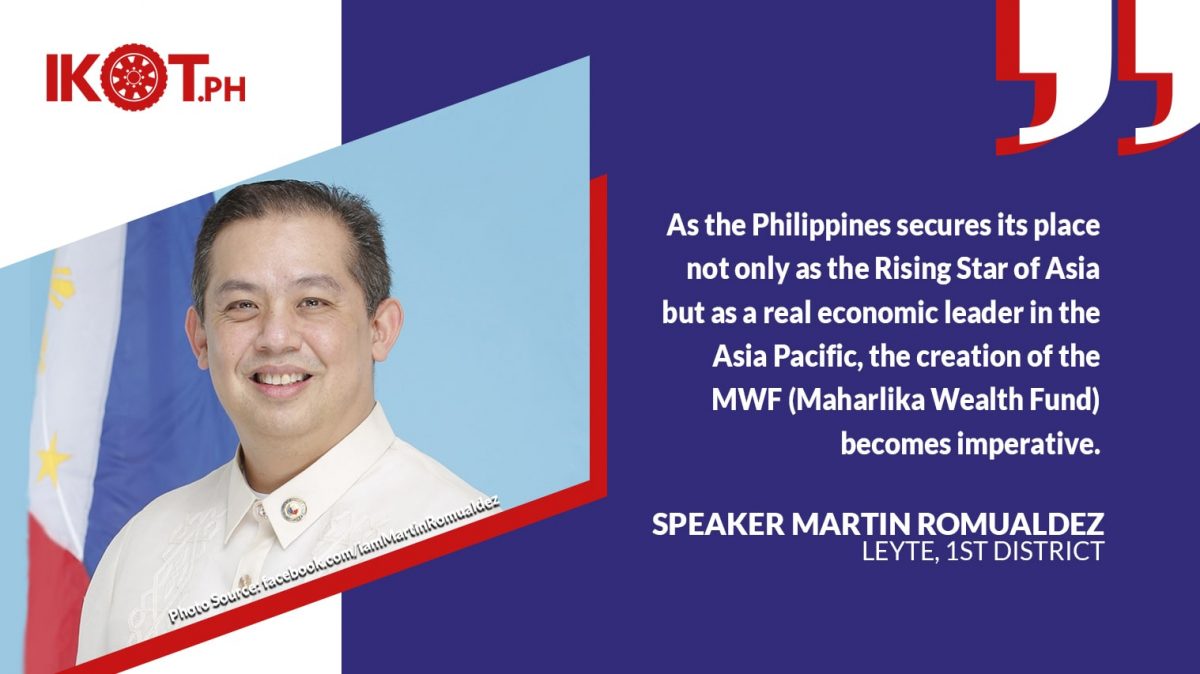Speaker Martin Romualdez proposed the creation of a sovereign wealth fund (SWF) to maximize the profitability of investible government assets for the benefit of all Filipinos.
The proposal is contained in House Bill (HB) No. 6398 that seeks the establishment of the Maharlika Wealth Fund, which would draw resources primarily from contributions from the Government Service Insurance System (GSIS), Social Security System (SSS), Land Bank of the Philippines (Land Bank), and Development Bank of the Philippines (DBP).
The House Committee on Banks and Financial Intermediaries recently approved and adopted the amendments introduced by the technical working group.
Other authors of the measure are House Majority Leader Mannix Dalipe, Senior Deputy Majority Leader Sandro Marcos, Tingog party-list Representatives Yedda Marie Romualdez and Jude Acidre, and Marikina City Representative Stella Quimbo.
The proposed Maharlika Wealth Fund (MWF) is patterned after the Sovereign Wealth Fund (SWFs) of 49 countries, including Singapore, China, Hong Kong, South Korea, Malaysia, Indonesia, Taiwan, Vietnam, and East Timor.
In filing the bill, the Speaker said to achieve the objectives of the Agenda for Prosperity and the eight-point socioeconomic roadmap of President Ferdinand Marcos Jr., it is essential for the government to “improve investment opportunities, promote productivity-enhancing investments, and ensure that the Philippines becomes an investment destination”.
“The MWF will provide for the management, investment, and use of the proceeds of the fund.”
The veteran legislator said the proposed MWF “will provide for the management, investment, and use of the proceeds of the fund”.
“Sovereign wealth funds are state-owned investment funds typically financed by a country’s surplus revenues or reserves. Governments invest these funds in an array of both real and financial assets to stabilize national budgets, create savings for their citizens, or promote economic development,” the seasoned lawmaker explained.
“The MWF will give the GSIS, SSS, Land Bank, and DBP the opportunity “to ensure their respective funds optimal asset allocation.”
He added that his proposal would give the GSIS, SSS, Land Bank, and DBP the opportunity “to ensure their respective funds’ optimal asset allocation as well as ensure that resources are efficiently channeled to investments that will provide the most value not only to the participating GFIs, but also to the country”.
Romualdez cited the cases of Singapore and Indonesia that have successfully used their sovereign wealth funds.
He said Singapore’s SWFs provide the financial means for the city-state “to manage its foreign reserves, defend itself and protect its sovereignty without compromising its domestic program, and augment its land-limited economic space with global investments”.
As for Indonesia, it has attracted foreign investors to jointly capitalize its SWF to bring in much-needed investments in such sectors as transportation, including airports, supply chains, logistics, digital infrastructure, the green economy, healthcare services, the financial sector, technology, and tourism, ultimately propelling the country’s growth.
“As the Philippines secures its place not only as the Rising Star of Asia but as a real economic leader in the Asia Pacific, the creation of the MWF becomes imperative,” Romualdez stressed.
To ensure transparency and accountability, he said the MWF would adhere to the Santiago Principles.
These are the 24 generally accepted principles and practices agreed to in October 2008 in Santiago, Chile, among countries with SWFs, investment recipient countries and international organizations.
The stakeholders committed to observe that SWFs will comply with all applicable regulatory and disclosure requirements in countries in which SWFs invest in and that the SWFs will have in place a transparent and sound governance structure that provides adequate operational controls, risk management, and accountability, among other commitments.
Under the bill, the envisioned MWF would have a governing board, composed of nominees of the contributing GFIs, which would be in charge of managing the fund.
The board would include two independent directors.


